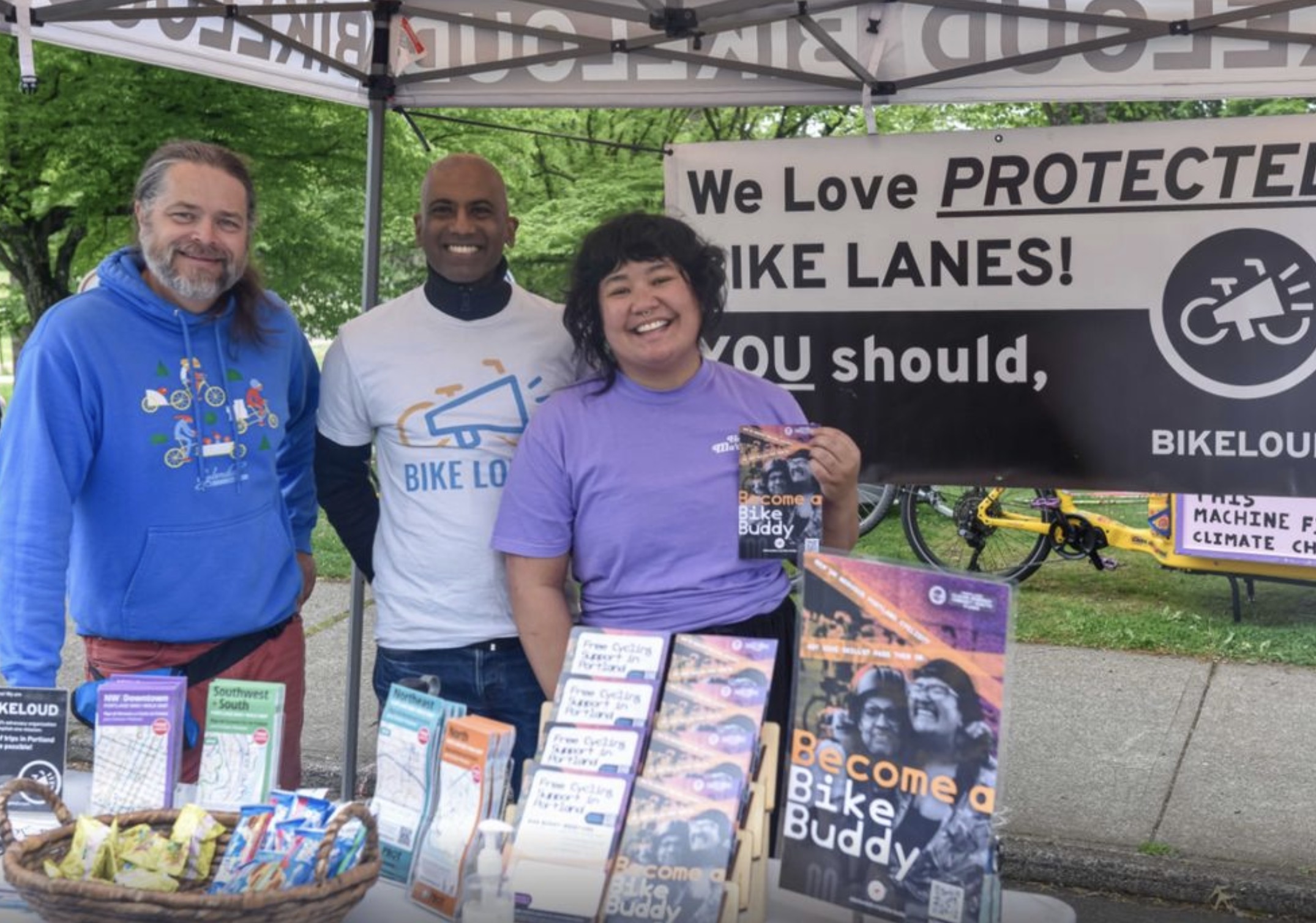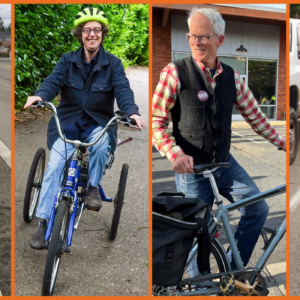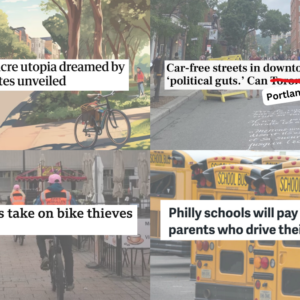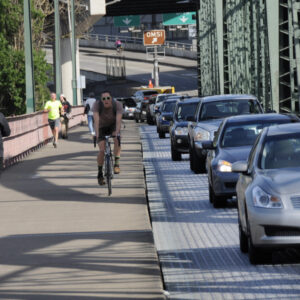
A guest article by BikeLoud PDX Board Member Cathy Tuttle.
Today is the first day of Week Without Driving and BikeLoud wants to help you take part.
A few years ago I led a BikeLoud Policy Ride to social service organizations in downtown Portland. I vividly remember the director of StoneSoupPDX, an organization that provides culinary training and community meals, saying that of the 80+ participants who had taken their culinary training program, only two had cars. People who do low-paying service jobs in places like restaurants often struggle to own and maintain a car.
It’s not surprising. Car ownership is simply too expensive for many of us. The American Automobile Association’s estimate for car loans, insurance, gas and maintenance (but not parking) pegs the 2024 average cost of owning a car at $12,297 a year or $1,025 a month. And a new study from Pew Research found that 1 in 10 American adults don’t drive.
The Week Without Driving challenges people who have the option to drive to learn firsthand about the barriers and challenges that nondrivers face, and work with nondrivers to create more accessible communities for all.
A big shout-out to Portland City Council members Mitch Green (D4), Sameer Kanal (D2), Tiffany Koyama Lane (D3) and Angelita Morillo (D3) who’ve already signed up to participate in some of the Week Without Driving. We’re expecting more city and business leaders to follow. Everyone can participate!
A Week Without Driving isn’t a disability simulation or a test of how easily you can find alternatives. We know that it is far easier to give up your keys if you can afford to live in a walkable area well served by transit, or can outsource your driving and other transport and delivery needs to other people.
America Walks, the organization that sponsors the national campaign says, “Having to drive during the challenge does not signify failure. Sometimes the best reflection comes when someone participating in the challenge has to drive. The point is to consider how someone without that option would have coped, and what choices they might have made.”
BikeLoud is leading a ride every day from September 29th to October 5th during the Week Without Driving: from a bike ride to the airport, to shopping by bike, to a ride that is focused on the Cost of Car Ownership, all led by Board members or former Board members. Our rides are listed on the Shift2Bikes calendar:
- Monday, September 29 Get groceries locally at Maglia Rosa & Sheridan, Joe Perez
- Tuesday, September 30 Ride to Vancouver, Martin Chasehill
- Wednesday, October 1 Lunchtime at the Farmers Market, Eva Frazier
- Thursday, October 2 Buy books locally at Powells, Joe Perez
- Friday, October 3 PDX Airport Ride, Kiel Johnson
- Saturday, October 4 Forest Park Bike & Hike, Peyton Blackwell
- Sunday, October 5 Cost of Car Ownership Ride, Shawne Martinez
Many BikePortland readers already get around without a car. That’s great! You can help your friends and neighbors join the movement by becoming a BikeLoud Bike Buddy or simply by being a great example of how liberating it can be to live your life carfree.








Thanks for reading.
BikePortland has served this community with independent community journalism since 2005. We rely on subscriptions from readers like you to survive. Your financial support is vital in keeping this valuable resource alive and well.
Please subscribe today to strengthen and expand our work.
> We know that it is far easier to give up your keys if you can afford to live in a walkable area well served by transit
Not directed to the guest author, but I mildly hate the common framing of “affording to live in a walkable area”. Phrased from a different perspective perhaps: some of us cannot afford to live in car-dependent neighborhood because the costs of car ownership is too high. Downtown and inner eastside has some of the highest proportion of low-income earners for a reason.
I just had a talk with a 22 year old co-worker about it. He lives under 4 miles away (less than 1/2 of my commute). He’s paying around $600/month to drive right now (he was ecstatic that his insurance just went down).
THe gravel bike I purchased because the roads in SE are so beat up now has just over 1,000 miles on it – I’ve spent $850 on it so far including new brake pads. I’ll have another 1,000 miles on it by Christmas before I need new pads. By then my cost per mile will be under $0.45.
To make understanding your comparison a bit easier, what is your co-workers cost per mile, excluding fixed costs? (Or including fixed costs if by not commuting he would get rid of his car, not keeping it for hiking or errands or rainy days.)
My cost to drive is well below $0.45 per mile.
Lol, this is a new bike (ridden for just over 3 months).
By the time I go part time (4 years) I’ll have 18,000 miles on it. I’ll have replaced the chain, cassette, tires and middle ring 4 times, add truing and other maintenance and I expect my total cost of ownership at that point to be under $1800, or around $0.10/mile. I expect this bike to last until I retire in 6 years (when my GF hits 62). At that point I’d expect it to hit $.08/mile like the road bike it replaced.
The discussion (with him) was about finances and retirement, so I’ll do the same basic math here that I did for him:
$600/mo (optimistic as that doesn’t include maintenance) is ~$758/month pre-tax contribution to a 401(k) (at his salary).
4 years of that is 36,000 (plus 4 years of growth, -$1,800 for a bike). (I’m using 4 years as the time frame as that’s what’s left on his loan).
By the time he’s 62 that will likely be $425,000 (The absolute $ value will be much higher, historically these funds return 10% over long horizons, 7% after inflation adjustment, so $425,000 in today’s dollars).
Those numbers don’t include the match (at that level he would max out at $2000 a year), now we’re talking $525,000 in todays dollars.
BTW my real world #’s (what both my GF and I put away in our 20’s and what it’s worth now) back those theoretical #’s up. We spent years below median household income while she went to school and then when I went back, but even so the money we put away back then is a big part of why we’ll be able to retire, move to Europe and travel in our early 60’s.
Back then we weren’t sure if Social Security would be around for us – it was clear that the constant raiding of the Social Security Trust by both parties was going to cause huge issues down the line, so we prioritized saving.
No car, very close budgeting for food etc. and when we got raises, it went into the 401(k) not our pockets as much as possible.
Through agressive pre-tax saving as our incomes grew we kept our AGI below median into the late aughts. I actually was a little bummed the year my AGI went above the threshold where I could get the $200 retirement contribution credit 🙂
Long after we could afford a car and still save at a good clip, we decided that we didn’t need one – hell, we’d been going for 20 years without one!
I completely believe that living without the cost of a car (especially one you need to finance) is a great way to save money, especially if you use it to invest for the future.
You are assuming that if your co-worker did not drive to work, he’d have no use for a car. I don’t believe that — most people are not willing to make the tradeoffs required to live car-free. You evidently are, and are looking forward to enjoying the payoff side of the equation.
What I know (having lived it) is if you don’t have a car you work out other ways to deal with the non-commute trips.
What I also know (since my co-worker from the 90’s did it) is that car-lite has some of the same benefits. He and his wife have used a single car for decades and they were able to turn the savings into retirement capital as well.
Also, even if you can’t do it for life – the time to do it is at 22 (he has no kids and you get best return on the investment) – even only a few years can make a huge difference (hence why I assumed investing for 4 years and then buying a car).
That made me chuckle… the possibility of a Portland family owning more than one car never occurred to me. In my family of 4 drivers, our one car sits idle most of the time, and we have never, not once, had a conflicting desire to use it.
Most couples I know (that includes my 22yr old co-worker) have 2 vehicles.
Rephrasing the money issue – 2 wage earners splitting the cost of a car (car lite) still leaves my co-worker the ability to hit the 6% 401(k) withholding necessary to get a 4% match.
Given his current wage, 3% COLA increases (he should go up more than that – he’s smart, hard working and has a great attitude, traits that got him the supervisor position at 22) he’d end up with enough in the 401(k) alone to replace 75% of his pre-retirement income at 62.
That’s gross – His net would replace 87% of his pre-retirement net due to lower taxes, no 401(k) withholding and no FICA.
I used a target date scenario with a very conservative glidepath. Use a delayed glidepath (start de-risking at 45) and you get 147% of that. That’s a pay raise at retirement (at 62) of 28%.
That’s the price of new(ish) cars.
Even projecting a 15year ownership of the car only takes it down to ~$500/mo over it’s lifetime (21 year old, purchases a $24k car new, 72mo loan, 7% interest, 35mpg, 10k miles per year).
Saving $250/mo post-tax is more than enough to hit the 6% withholding to get his 4% match.
If more people approached money the way you do, they’d be a lot better off.
Lol – that got sent before I was done 🙂
THe discussion was about money and the fact that I’ll be able to go part-time in 4 years before retiring completely in 6. The lack of a car all these years is a direct cause of that.
There is a significant portion of daily car trips that are individuals using their vehicles for income. Amazon, Uber/Lyft, Walmart, Instacart, DoorDash – these are also marginalized people, often recent immigrants, scraping together a living. Unfortunately they are so poor and marginalized as to never even be recognized by the groups that make decisions which effect them.
Getting “choice drivers” and others who can easily bike but instead drive, would only help the people who have to drive for business.
Feels like you’re trying to drive a wedge here, and I don’t think it’s necessary. From the sounds of things…
…the point of the week is to develop empathy for folks who are less fortunate. Seems like a more functional transportation network would help the folks who can’t or must drive alike.
Are you driving this week Jonathan? What about the rest of your family?
Hard to say. Depends on what comes up. I’m sure my wife will drive, but we’ll talk about how to avoid it!
I’d love to see a guest column from your wife explaining her driving habits and thoughts on cycling.
You’d think that a “moderate” would understand that the perfect is the enemy of the good.
I believe Councilor Morillo uses transit (or did) but it would be nice to know more about how the councilors will participate. For example, it would be very cool if they have committed to not driving for a week.
Maybe they aren’t driving in the sovereign citizen sense of “I’m not driving, I’m traveling”
Those things help, but it’s easiest to give up your keys if you realize most people don’t need them and how easy it is without them.
Portland is the only place I’ve lived that would be considered walkable (and the only place served by transit), and until I started working from home a few years ago, the closest I’ve ever lived from work is 7 miles one way (have been in the workforce > 40 years), and my current home is the only time I’ve lived close to businesses. I’ve had a vehicle all that time, but I typically go weeks (months sometimes happens) without driving and have to charge the battery because I don’t drive enough to keep the battery charged.
Unlike many here, I am not at all anti car and consider that attitude unhelpful for encouraging new riders. It’s self-othering and insanely ablest — openly trying to make life harder for huge numbers of people who already have it tough is messed up.
I also don’t think it tempts anyone to ride when the focus is constantly on the negative — i.e. lack of infrastructure, bad drivers, cold/heat/wet/darkness, sweat, mechanicals, etc. All of these things are inherent parts of riding and people who can’t learn to embrace these things won’t be able to stay out there. Most people can’t embrace that stuff, and throwing shade on them for that only discourages the fence sitters who could potentially become riders.
I am intrigued by the airport ride since I only live about 8 miles away. Getting there/back is not the issue — it’s having my bike still not stripped while I’m gone. What are people doing? And BTW, transit to the airport is virtually useless for many people. It neither runs early nor late enough and it’s an hour and a half each way for me — it took me less time to drive when I lived in Monmouth 73 miles away.
I am interested in the airport ride, too. When I followed the link, the description explains, “BikeLoud PDX will ride to the airport and see how this important bicycling connection can be made more accessible.”
That matches up with my previous experience: last fall I tried to ride to the airport as an excuse to check out the new bike bridge for Gateway Transit to Gateway Green, Gateway Green and the new airport path. I tried following the signs from the 205 path to the airport and I kept getting lost and having to double back. At one point, the bike lane along 82nd way ended and I had to get on the sidewalk. The ped signal at Airport Way gave me the “walk sign” to cross at the same time multiple car lanes were given a green arrow to turn across the crosswalk I was using! The whole experience was pretty depressing, and I am not sure I it is worth it to me to advocate for a better route. I would prefer to advocate for a route that would likely serve me and more more people more often, like a better route from North Portland to Downtown!
In all fairness, cycling to the airport isn’t a real use case to a fraction of a percent of people for reasons that have nothing to do with infrastructure.
You have to be an exceptionally light traveler — you have to carry all your luggage including tools and weather gear (which you absolutely need if you don’t want to run the risk that a garden variety issue will strand you)
I would say this would be a great use case for rentable e-bikes, but I wouldn’t trust them to be there (or reliable) when I need to be thousands of miles away or am working my way home after midnight.
There are some other paths in. Since you were coming in via 82nd, I think you would’ve been much happier with Cully/Alderwood, but there are still the other issues inherent to airport travel. What’s really needed is better transit — very specifically express transit
And also all the connectors and feeders that let you get from Gateway or Downtown or wherever the transit goes to the place you want to go, at the odd hours many of us fly.
Reliable transit to the airport is expensive to provide, and most people who have a choice won’t use it anyway because of the time involved and lack of control over the schedule.
I do use it, but rarely see more than a couple of other airport-bound people on the Max with me. I usually see hundreds of cars heading there at the same time, and I occasionally need to bail and take an uber because of ghost trains, delays, or missed connections.
I’m an odd bird indeed.
If someone lives along the red line, it really is the best option for the airport, but adding in a bus transfer kind of kills it as a fast option.
It would be amazing if the red line ran through the airport station, tunneling to the SW and emerging on Lombard, to then travel west to St Johns, intersecting the Yellow Line at Interstate.
Transit from St Johns (and to a lesser extent NoPo) to PDX is useless. Would love to see your proposed line happen, but pretty sure it won’t be in my lifetime.
Despite not being anti car in general — the daily/nightly clusterfarce is easily enough to convince me to seek any other way to get in/out. But I’d say that for traffic in general. No way I’d live here if I had to sit in that like practically everyone else.
totally agree